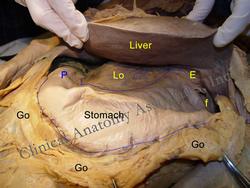| The origin or etymology of the word [omentum] is not clear. The plural form is [omenta] and it refers to membranes associated with the stomach. The term was first used by Galen and later by Celsus. It was Andrea Vesalius who gave us the first clear anatomical description of the omenta.
The omenta are double-layered peritoneal membranes. There are two omenta. The lesser omentum ("Lo" in the image) extends between the liver and stomach, and liver and the first part of the duodenum. The greater omentum ("Go" in the image) projects off the stomach, reaches as low as the lower abdominal cavity and reflects superiorly to connect with the transverse colon. The greater omentum contains a larger amount of fat than the lesser omentum. Both omenta contain a number of arteries, veins, and other structures between their layers. In the case of the greater omentum, we find the right and left gastroepiploic arteries as well as the greater curvature vascular arcade. Images property of: CAA.Inc.. Photographer: D.M. Klein |
 Go= Greateromentum, Lo=Lesseromentum, E=Esophagus, f=fundus, P= Pylorus. |
| Back to MTD Main Page | Subscribe to MTD |